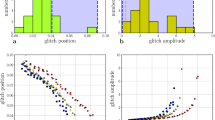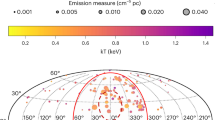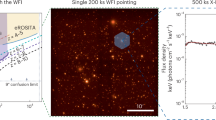Abstract
DURING the past few years there has been some progress in understanding the way in which a star approaches the main sequence. In their studies of the pre-main sequence evolution of stars, Ezer and Cameron1 assumed that the stellar material started with the highest possible adiabat consistent with the virial theorem (for a given temperature a high adiabat has a low density and a low adiabat has a high density). In later hydrodynamic collapse studies of the formation of a star with zero angular momentum, Hayashi2 and Larson3 showed that much of the internal energy of the collapsing gas is radiated away, so that the stellar material must start on a much lower adiabat. The gas in the centre of such an object can only be heated by compression, so that it remains on a low adiabat. As the outer layers of the star fall onto this core, they undergo shock heating, due to gravitational potential energy release, which raises their adiabat, and allows the star to form a stable body in hydrostatic equilibrium prior to reaching the main sequence.
This is a preview of subscription content, access via your institution
Access options
Subscribe to this journal
Receive 51 print issues and online access
$199.00 per year
only $3.90 per issue
Buy this article
- Purchase on SpringerLink
- Instant access to full article PDF
Prices may be subject to local taxes which are calculated during checkout
Similar content being viewed by others
References
Ezer, D., and Cameron, A. G. W., Can. J. Phys., 43, 1497 (1965).
Hayashi, C., Ann. Rev. Astron. Astrophys., 4, 171 (1966).
Larson, R. B., Mon. Not. Roy. Astron. Soc., 145, 271 (1969).
Cameron, A. G. W., Icarus (in the press).
Cameron, A. G. W., and Pine, M. R., Icarus (in the press).
Field, G. B., in Field, G. B., Somerville, W. B., and Dressler, K., Ann. Rev. Astron. Astrophys., 4, 207 (1966).
Keays, R. R., Ganapathy, R., and Anders, E., Geochim. Cosmochim. Acta, 35, 337 (1971).
Laul, J. C., Keays, R. R., Ganapathy, R., Anders, E., and Morgan, J. W., Geochim. Cosmochim. Acta, 36, 329 (1972).
Laul, J. C., Ganapathy, R., Anders, E., and Morgan, J. W., Geochim. Cosmochim. Acta (in the press).
Jeffery, P. M., and Anders, E., Geochim. Cosmochim. Acta, 34, 1175 (1970).
Vardya, M. S., Mon. Not. Roy. Astron. Soc., 129, 345 (1965).
Stewart, J. C., and Pyatt, K. D., Astrophys. J., 144, 1203 (1966).
Rouse, C. A., Phys. Rev., 159, 41 (1967).
Chandrasekhar, S., Introduction to the Study of Stellar Structure (Univ. Chicago Press, Chicago, 1939).
Herbig, G. H., Vistas in Astron., 8, 109 (1966).
Iben, jun., I., and Talbot, R. J., Astrophys. J., 144, 968 (1966).
Ezer, D., and Cameron, A. G. W., Astrophys. Space Sci., 10, 52 (1971).
Author information
Authors and Affiliations
Rights and permissions
About this article
Cite this article
PERRI, F., CAMERON, A. Hydrogen Flash in Stars. Nature 242, 395–396 (1973). https://doi.org/10.1038/242395a0
Received:
Issue date:
DOI: https://doi.org/10.1038/242395a0
This article is cited by
-
Properties of the solar nebula and the origin of the moon
The Moon (1973)



